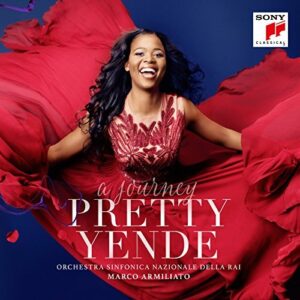What a lovely sound Pretty Yende makes! The South African soprano has a warm vibrato, a distinctly forward sound, excellent coloratura, and secure high notes (including an E-natural that nobody asked for at the end of an otherwise very entertaining “Un voce poco fa”, which includes some delightful, unexpected embellishments). The “Journey” of the title refers, I believe, to Yende’s voyage from the tiny South African township where she was born to the world’s great opera stages, and the charming fact that her interest in opera was sparked by the British Airways ad that featured the duet from Lakmé, which is included here and gorgeously performed by Yende and mezzo Kate Aldrich.
I don’t want to throw a monkey wrench into the apparent love-fest Yende has created, but I can’t avoid some truths: While the operative word is most assuredly “lovely”, Yende’s interpretive abilities are, at least in these seven selections, somewhat limited. “Una voce…” has the usual perky spark that high sopranos bring to it and she is interesting in the recit from Beatrice di Tenda’s big scene, using fine portamento; but then she just offers roulade upon roulade, thinking little of the situation. Adèle’s opening aria from Le Comte Ory is deliciously sung but does not capture the drama-queen melancholy of the words, and the final E-flat is like a train whistle.
It turns out that she can exclaim, as the glorious “Poison” aria from Gounod’s Roméo proves, and it’s a very exciting performance. Her reading of Lucia’s “Fountain Scene” is by the numbers, and her pitch wavers in the role’s middle-voice moments. The Puritani “Mad Scene” is almost perfectly sung, but I suspect few will be moved by it. Marco Armiliato leads his Italian Orchestra with great respect for the singer and little else.
Yende is in the same company as, say, Anna Moffo, but without the latter’s ability to caress a phrase. I mean the young Moffo, so this is a great compliment, but more than that I’m making a distinction between her and coloraturas like Roberta Peters and dramatic coloraturas like Callas. She’s certainly a great asset to the world of opera, but wouldn’t it be great if she would offer the type of true expression to all of her work as she does to Juliette?
































